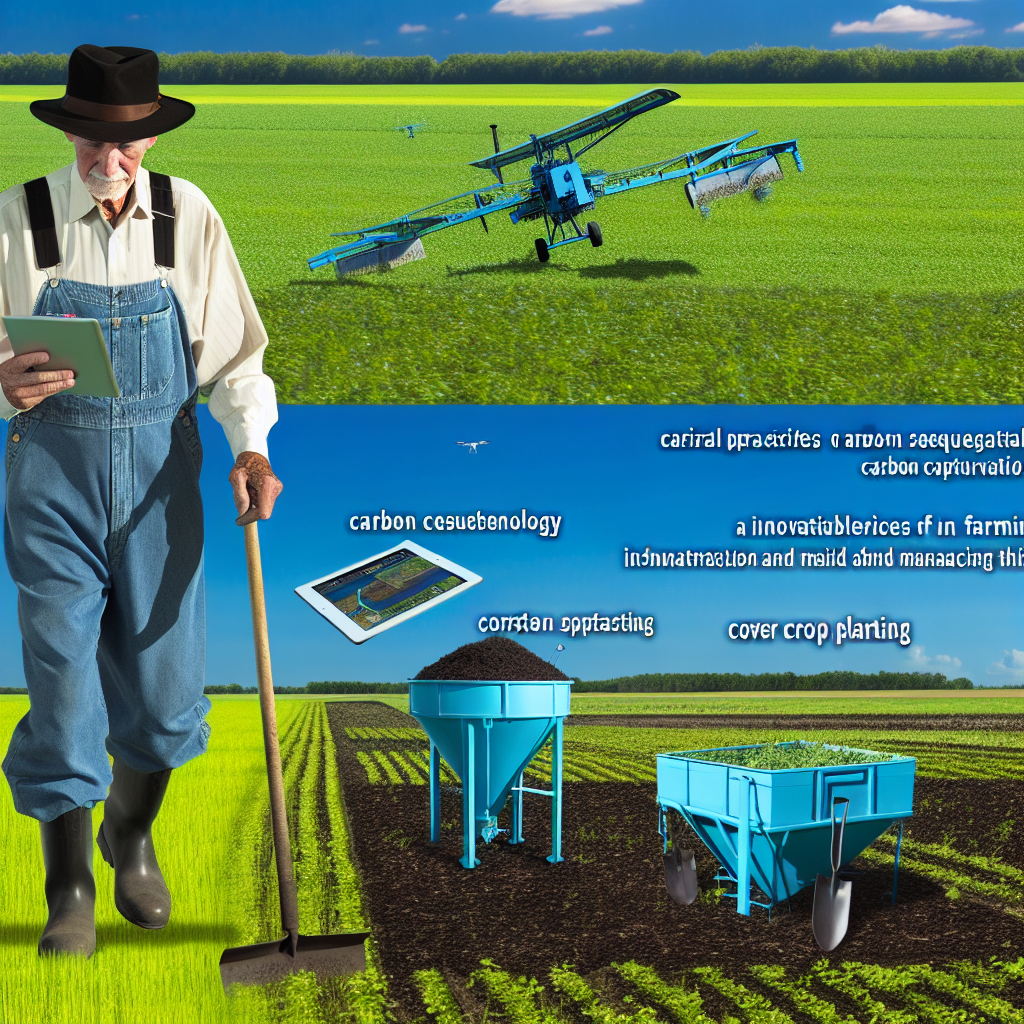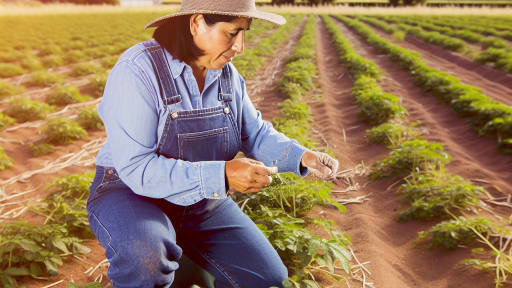Understanding Carbon Sequestration
Basics of Carbon Sequestration
Carbon sequestration involves capturing carbon dioxide from the atmosphere.
This process prevents carbon from contributing to climate change.
It plays a critical role in agriculture by enhancing soil health.
Farmers can utilize various methods to sequester carbon effectively.
Importance in Farming
Sequestering carbon improves overall soil quality and fertility.
It increases crop productivity, benefiting farmers economically.
Furthermore, it supports sustainable farming practices, enhancing resilience.
Healthy soils also help in water retention, reducing irrigation needs.
Benefits of Carbon Sequestration
The primary benefit includes mitigating climate change effects.
It also aids in reducing greenhouse gas emissions from farming practices.
Moreover, improved soil health leads to increased biodiversity on farms.
Farmers employing these practices often gain market advantages.
Challenges Faced
Despite its benefits, several challenges hinder carbon sequestration efforts.
Initial costs of implementing new practices can be high for farmers.
Additionally, knowledge and training are often insufficient in rural areas.
Transform Your Agribusiness
Unlock your farm's potential with expert advice tailored to your needs. Get actionable steps that drive real results.
Get StartedWeather variability also complicates the effectiveness of these practices.
Cover Cropping: Enhancing Soil Health and Capturing Carbon
Introduction to Cover Cropping
Cover cropping is a sustainable farming practice.
It involves planting crops specifically to improve soil health.
This technique also contributes to carbon sequestration.
Farmers can utilize diverse species for cover crops.
Benefits of Cover Cropping
Cover crops provide multiple benefits to farmers.
First, they enhance soil structure and fertility.
This leads to improved water retention in the soil.
Additionally, they reduce soil erosion significantly.
Moreover, cover crops can suppress weeds effectively.
They create a habitat for beneficial organisms.
These organisms improve soil health and stability.
Types of Cover Crops
Farmers can choose from various cover crop types.
Leguminous cover crops like clover fix nitrogen in the soil.
Grasses such as rye offer excellent ground cover.
Brassicas, including radishes, break up compacted soil.
Implementing Cover Cropping Strategies
Effective planning is critical for cover cropping success.
Farmers should select compatible cover crops for their climate.
Timing is also essential; sow cover crops after cash crops.
Incorporating cover crops into crop rotations enhances benefits.
Farmers must monitor soil moisture levels regularly.
Measuring Carbon Sequestration
Measuring the impact of cover cropping on carbon sequestration is vital.
Farmers can use soil testing to assess changes in organic carbon levels.
Additionally, they can track improvements in crop yields.
Showcase Your Farming Business
Publish your professional farming services profile on our blog for a one-time fee of $200 and reach a dedicated audience of farmers and agribusiness owners.
Publish Your ProfileThis data supports the case for sustainable practices.
Real-World Applications
Many farmers successfully implement cover cropping today.
For instance, Sarah Thompson of Green Acres Farm uses clover.
She noticed increased soil fertility and crop resilience.
Tom Wilson from Eco Fields switched to a mix of radishes and rye.
This approach significantly improved his soil structure.
Future of Cover Cropping
The future looks promising for cover cropping practices.
More farmers are recognizing the environmental benefits.
Government incentives may encourage wider adoption.
As awareness grows, sustainable farming practices will expand.
Agroforestry Practices: Integrating Trees into Agricultural Systems
Overview of Agroforestry
Agroforestry combines agriculture and forestry practices.
This approach benefits both the environment and farming productivity.
Farmers can diversify their crops and enhance land use.
Types of Agroforestry Systems
Agroforestry encompasses several systems.
- Alley cropping involves planting trees and crops together.
- Silvopasture integrates trees with livestock grazing.
- Forest farming cultivates high-value crops under a tree canopy.
Benefits of Integrating Trees
Integrating trees into farming systems offers numerous advantages.
First, trees improve soil quality and structure.
Additionally, they help retain water and reduce erosion.
Moreover, they enhance biodiversity and provide habitat for wildlife.
Carbon Sequestration Potential
Trees play a crucial role in carbon sequestration.
They absorb carbon dioxide from the atmosphere during photosynthesis.
This process helps combat climate change and reduces greenhouse gases.
Farmers can integrate carbon offset schemes to enhance their income.
Implementing Agroforestry Practices
Farmers should consider several factors when implementing agroforestry.
Soil type and climate significantly influence tree selection.
Additionally, the choice of crop pairs with trees is vital.
Farmers can receive technical and financial support from agricultural agencies.
Case Studies and Success Stories
Numerous farmers successfully implement agroforestry practices worldwide.
For example, Maria Gonzalez in Brazil uses alley cropping effectively.
Her practices have increased yields and improved soil health.
Similarly, John Mitchell in Australia combines livestock and trees.
This integration has enhanced his farm’s sustainability and productivity.
Delve into the Subject: Carbon Sequestration Practices for Sustainable Farms
No-Till and Reduced Tillage Methods
Introduction to Tillage Practices
No-till and reduced tillage practices effectively enhance soil carbon storage.
These methods significantly limit soil disturbance, allowing carbon to accumulate in the soil.
Understanding No-Till Farming
No-till farming involves planting crops directly into undisturbed soil.
This practice conserves soil structure and moisture by minimizing disruption.
Farmers utilize specialized equipment to drill seeds into the ground.
As a result, no-till techniques improve organic matter retention.
Benefits of Reduced Tillage Methods
Reduced tillage combines the benefits of tillage with soil conservation practices.
These practices lessen soil erosion and promote soil health.
Showcase Your Farming Business
Publish your professional farming services profile on our blog for a one-time fee of $200 and reach a dedicated audience of farmers and agribusiness owners.
Publish Your ProfileFarmers frequently use shallow tillage methods, which disturb the topsoil less.
This approach preserves essential microorganisms in the soil ecosystem.
Incorporating Cover Crops
Cover crops play a vital role in both no-till and reduced tillage systems.
They protect soil from erosion and add organic matter during off-seasons.
Cover crops also enhance nutrient cycling and improve soil structure.
Farmers like Clara Reed grow winter rye to benefit their soil ecology.
Carbon Sequestration through Tillage Practices
Both no-till and reduced tillage significantly improve carbon sequestration.
These methods allow soil to store more carbon dioxide, thus mitigating climate change.
According to research, no-till systems can increase soil organic carbon levels by up to 30% over time.
Policy Support for Sustainable Practices
Governments can encourage these practices through incentives and education.
Programs focusing on sustainable farming practices can enhance carbon storage in agriculture.
Organizations like the Soil Health Partnership advocate for no-till farming.
Their efforts help promote broader adoption among farmers.
Challenges and Considerations
Implementing no-till and reduced tillage practices may present challenges.
Some farmers worry about herbicide reliance in these systems.
Additionally, transitioning requires education and investment in new equipment.
However, the long-term benefits far outweigh the initial obstacles.
Learn More: Sustainable Farming Practices Boosting Biodiversity
Pasture Management: Rotational Grazing for Carbon Sequestration
Overview of Rotational Grazing
Rotational grazing involves moving livestock between pastures periodically.
This practice helps maintain healthy grassland ecosystems.
It promotes soil health and increases carbon sequestration.
Benefits of Rotational Grazing
One main benefit is improved pasture productivity.
Another benefit is enhanced soil structure.
Additionally, rotational grazing increases water retention in the soil.
Enhancing Soil Structure
Rotational grazing prevents overgrazing, allowing grass to recover.
As a result, roots grow deeper and strengthen the soil.
Increasing Carbon Sequestration
This practice significantly boosts the carbon content of the soil.
Healthy grasses capture more carbon dioxide during photosynthesis.
Implementing Rotational Grazing
Farmers can start by dividing fields into smaller paddocks.
Next, they allocate grazing time for each paddock.
For example, a few days of grazing can follow with rest periods.
Setting Up a Grazing Schedule
Establish a schedule based on grass growth rates.
Monitor pasture health to adjust the timing as needed.
Monitoring and Adjustments
Regularly evaluate soil health and pasture productivity.
Adjust grazing patterns to optimize growth and carbon capture.
Challenges and Solutions
Some challenges include initial setup costs and labor requirements.
To overcome this, farmers can seek grants or cooperative assistance.
Community Support and Resources
Engaging with local agricultural extension services can help.
Collaborating with neighboring farmers fosters shared insights and solutions.
You Might Also Like: Choosing the Right IPM Tools for Your Farm
Showcase Your Farming Business
Publish your professional farming services profile on our blog for a one-time fee of $200 and reach a dedicated audience of farmers and agribusiness owners.
Publish Your Profile
Biochar Application: Transforming Waste into a Carbon Sink
Introduction to Biochar
Biochar is a stable form of carbon made from organic materials.
Farmers can produce biochar through pyrolysis.
This process heats biomass in the absence of oxygen.
This technique reduces greenhouse gas emissions while enhancing soil health.
Benefits of Biochar in Agriculture
Applying biochar can significantly improve soil fertility.
It enhances the soil’s ability to retain moisture.
Additionally, biochar promotes beneficial microbial activity.
As a result, crops can grow stronger and healthier.
Furthermore, biochar helps sequester carbon in the soil.
Production Methods of Biochar
Farmers can use various biomass sources for biochar production.
Common feedstocks include agricultural residues and wood chips.
- Corn stalks
- Wheat straw
- Saw dust
Pyrolysis units can vary in size and design.
Some small-scale producers opt for portable units.
Applications of Biochar in Farming
Farmers can apply biochar directly into the soil.
They can also mix it with compost for enhanced benefits.
Using biochar in planting holes can boost seedling growth.
Moreover, it serves as an effective mitigator for soil erosion.
Challenges of Biochar Implementation
While biochar offers numerous benefits, challenges exist.
First, the initial investment for production can be high.
Additionally, education on proper application techniques is crucial.
Farmers must understand local soil conditions for optimal results.
Future Directions for Biochar in Sustainable Agriculture
Research continues to explore the full potential of biochar.
Innovations in production methods will improve efficiency.
Networking among farmers can share best practices effectively.
Ultimately, biochar can play a pivotal role in sustainable farming.
See Related Content: Carbon Sequestration Technologies for Modern Farms
Soil Amendments: Utilizing Organic Matter to Boost Carbon Levels
Introduction to Soil Amendments
Soil amendments play a vital role in enhancing soil quality.
They improve soil structure and nutrient availability.
Furthermore, they aid in increasing carbon sequestration in agricultural lands.
Types of Organic Matter for Soil Amendments
Organic matter comes in many forms suitable for soil amendments.
Compost is one of the most common options used by farmers.
Additionally, cover crops can also contribute valuable biomass to the soil.
Manure from livestock serves as another effective organic amendment.
- Compost increases microbial activity.
- Cover crops prevent erosion and enhance soil coverage.
- Manure adds significant nutrients and organic matter.
Benefits of Using Organic Matter
Incorporating organic matter enriches the soil significantly.
It enhances water retention capacity, benefiting crops during dry spells.
Moreover, it encourages the growth of beneficial microorganisms.
This process results in improved soil health and fertility.
Implementation Strategies
Farmers can adopt various strategies for effective implementation of organic amendments.
Regular testing of soil helps determine the appropriate type and quantity of organic matter.
Rotating crop types can also optimize nutrient use from organic amendments.
Showcase Your Farming Business
Publish your professional farming services profile on our blog for a one-time fee of $200 and reach a dedicated audience of farmers and agribusiness owners.
Publish Your ProfileTiming and Application Methods
Applying organic matter at the right time maximizes its benefits.
Consider adding amendments during soil preparation.
Also, side-dressing during the growing season can enhance nutrient uptake.
Challenges in Using Organic Amendments
Despite numerous benefits, challenges exist with organic amendments.
One common issue is the variability in nutrient content.
Additionally, sourcing high-quality organic matter can be difficult.
Farmers need to remain educated about these challenges to adapt effectively.
Future Outlook
Advancements in technology continue to improve soil amendment practices.
Research into biochar and other innovative amendments shows promise.
Ultimately, increased adoption of organic amendments can significantly enhance carbon sequestration.
This shift is crucial for sustainable farming and climate change mitigation.
Innovative Technologies in Carbon Measurement and Monitoring for Farmers
Advancements in Sensor Technology
Farmers can use advanced sensor technology to monitor carbon levels effectively.
These sensors provide real-time data on soil conditions.
They measure moisture, temperature, and carbon content.
As a result, farmers can make informed decisions about their farming practices.
Utilizing Remote Sensing
Remote sensing offers a broader perspective on carbon sequestration efforts.
Drones and satellites can track vegetation growth and land use changes.
This technology allows farmers to assess the effectiveness of their practices.
Furthermore, it helps in identifying areas needing improvement.
Soil Health Monitoring
Soil health is crucial for effective carbon sequestration.
Farmers can utilize soil testing kits to analyze carbon levels.
Regular monitoring helps in understanding soil dynamics.
With this knowledge, farmers can adopt better management practices.
Data Analytics and Modeling
Data analytics plays a vital role in carbon measurement.
Agricultural data can predict carbon storage potential accurately.
Farmers can employ models to simulate various farming scenarios.
These models help in understanding the long-term impacts of their practices.
Mobile Applications for Monitoring
Mobile applications have become user-friendly tools for farmers.
These apps enable easy tracking of carbon sequestration metrics.
They also offer insights and recommendations tailored to specific farms.
Consequently, farmers can optimize their practices on the go.
Additional Resources
Climate-Smart Agriculture and Forestry Resources | Farmers.gov
NRCS Climate-Smart Mitigation Activities | Natural Resources …




